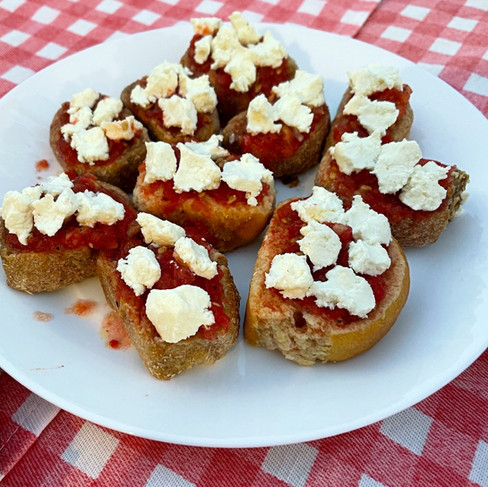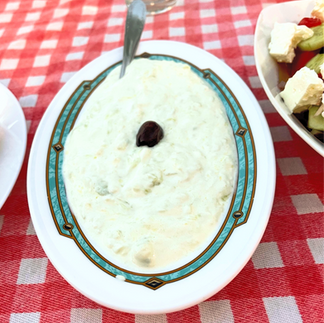
On our last evening on Crete in Greece, we spent an evening of education and deliciousness with The Real Cretan Cooking Experience by Fabulous Crete. It was an immersion in Cretan culture, cuisine and sharing the fruits of our labors with fellow food loving travelers. We gained insights into how history impacted the flavors we enjoyed, how wine and olive oil was as much a food source as a currency to be used for trading with neighboring islands, and how the Cretan diet is largely based on the food that is grown on the island.
Looking for more information on visiting Greece,
check out my other blog posts.
Meet Our Group

We were picked up at our lodgings and taken out to a beautiful farmhouse at the foot of the White Mountains that run along the spine of Crete. We met our fellow foodies there. It was an international group, with people from Europe, the United Arab Emirates, and the United States.
Cretan History

First we received a history lesson and background information that gave our culinary activities context. It gave us an understanding of why we were using specific ingredients and how those ingredients and preparations found their way to Cretan Cuisine.
Hands on Cooking

After our history lesson, we washed our hands, donned our aprons and got to work preparing our Cretan Feast. We joined our fellow food lovers, immersing ourselves in the flavors of Crete.
First step is chopping the herbs. Most Cretan dishes are flavored with fresh dill, oregano, mint, fennel and parsley. These herbs are found in the stories of Greek Mythology, which indicates that they were used by the Minoans more than 3500 years ago. The Minoan Society predates the Golden Age of Greek Civilization. Many of the Greek Myths are based on stories of the Minoans, passed on verbally from generation to generation.
Parsley was believed to have sprung from the Greek hero, Archemorous. According to legend, the plant first sprouted in the blood of Archemorus. This myth caused the ancient Greeks to hold the belief that parsley was sacred and also evil. These herbs were used as medicine as well as for enhancing the flavor of food. Oregano is believed to help reduce coughs. Oregano also might help digestion by increasing bile flow and fighting against some bacteria.
A Visit to the Garden

Historically, Cretans had to eaten what they could grow because they live on an island. Those habits have not died with modern life. On almost every balcony and in every yard, you see gardens and pots of herbs. There is a big emphasis on growing organically. The patio where we did our food preparations and enjoyed our dinner overlooked this garden.
Traditional Greek dishes Gremista and Dolmades are stuffed vegetables and stuffed grape, cabbage or collard leaves. In modern Greek cuisine these vegetables are stuffed a mixture who's main ingredient is rice. While Alexander the Great was introduced to rice, rice production did not come to Greece until the 1950's. Before rice, grape leaves and vegetables were stuffed with bulgar wheat or barley. Another interesting fact about these stuffed delicacies is that the rice is not cooked before stuffing it into the vegetables. Grated tomatoes, olive oil and water are added into the mixture to cook the rice while it bakes.

Our food preparation was completed while enjoying this stunning view!
Feeding the Goats
We took a break from food preparation to feed the goats. Goats are indigenous to Crete. They are raised for their milk which is used to make cheese and yogurt. They are also used as meat, although the traditional Cretan diet contains only minimal amounts of meat and fish.
JOIN MY EMAIL LIST
Back to the Kitchen

The box grater is a key implement in Greek Cooking. They use them to grate the onions that go into the vegetable and grape leaf stuffing. They grate the cucumbers that go into the Tzatziki Sauce. They also grate the tomatoes that top the Dakos, a bruschetta like starter.
There is an art to stuffing the grape leaves. The key is to hold it in the palm of one hand and fold in the edges and roll with your other hand. CaptK was a quick learner.
One of the interesting things about Cretan Food is the amount of olive oil that goes into each dish. Even the Kalitsounia, cheese pies, use olive oil to bind the dough. Of course the finished product is fried in olive oil.
Tasting Cretan Wine

Wine has a starring role in Greek Culture. It has been made on Crete for 3500 years. The Romeiko grape is indigenous to Crete and grown predominantly in western Crete. This is a red grape that when fermented in a traditional manner, gives you nondescript brownish colored wine. When the Romeiko grape is fermented in nontraditional methods, it yields a delightfully crisp white wine. It pairs well with the nutty, salty Cretan Graviera cheese that is made with sheep's milk and no more than 20% goat's milk.
A Lesson in Traditional Home Arts

The farmhouse we visited has serval rooms that are set up as a museum of traditional household practices. This loom was used by the owner's grandmother to weave blankets for their family.
Eating Traditional Cretan Food
After the Stuffed Vegetables cooked for an hour and a half, we sat down at a communal dinner table to enjoy our Cretan feast. We started with the bruschetta like Dakos, that use Barley Rusks as the base and creamy fresh Myzithra topping the tomato mixture. Our other starter was the crispy Kalitsounia (cheese pies). I dipped my Kalitsounia in the Tzatziki Sauce.
We enjoyed a traditional Greek Salad with locally grown tomatoes, cucumbers, bell peppers and onions all tossed with Myzithra Cheese, cured olives, oregano, and olive oil. In restaurants, you will see both Greek and Cretan salads. The Cretan Salad includes wild greens, as well all the ingredients from a traditional Greek Salads. The Cretan Tzatziki Sauce is unique in that it does not the herb, Dill, Mint, Oregano that you find in Tzatiki Sauces in other places. An interesting note is that the Dolmades, stuffed grape leaves, were cooked on top of the Gemista, stuffed vegetables. Cooking them in this manner, made the Dolmades extra flavorful.

Spending an evening of education on the cuisine and culture of Crete with fellow food lovers was a delicious ending to our time in Crete.
Ready to book your trip to Crete, check out the low prices for lodging on Booking.com.
These are four places, I would highly recommend:















































Comentarios